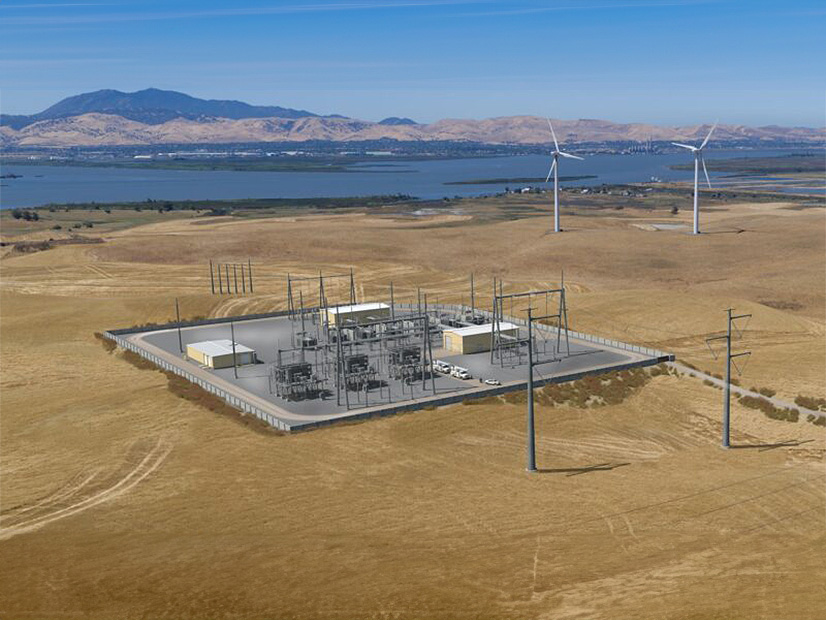FERC on July 25 approved two incentives Pacific Gas and Electric requested to support work it will undertake with LS Power Grid California for four transmission projects included in CAISO’s 2021/22 transmission plan (EL24-107).
In an order issued at its monthly open meeting, the commission found the projects satisfy the Order 679 requirements for incentive rate treatment because they will improve reliability and reduce congestion. Commissioner Mark Christie dissented in the 2-1 vote.
FERC approved use of the Construction Work in Progress (CWIP) and the abandoned plant incentives for PG&E’s supporting work to interconnect and integrate the Collinsville, Manning, Newark and Metcalf projects into CAISO’s grid, which will help offset associated costs and address long lead times.
After becoming sponsor, LS Power also was awarded transmission rate incentives for the projects in March 2023.
The Collinsville Project consists of a new 500/230-kV substation, two new 230-kV transmission lines to the Pittsburg substation, looping in the Vaca Dixon/Tesla 500-kV line into the Collinsville substation and adding a series capacitor to the Collinsville/Tesla line.
The project, which is estimated to cost between $475 million and $675 million, will mitigate a constraint on the Cayetano-North Dublin 230-kV line, increasing reliability and facilitating renewable generation in the northern Bay Area, according to PG&E. It’s estimated to cost PG&E $197.9 million to complete several updates, including constructing several lattice structures, new bays and line swapping, decreasing existing series capacitor banks, adding a telecommunications path and adding breakers.
The Manning project will consist of a new 500/230-kV substation and two new 230-kV transmission lines to the Tranquility substation, looping the PG&E Panoche-Tranquility transmission lines and the Los Banos-Midway and Los Banos-Gates 500-kV lines into the Manning substation. It’s estimated to cost $325 million to $485 million and will mitigate the constraint on the Borden-Storey 230-kV transmission line, allowing for the advancement of renewable generation in the Westlands or San Joaquin areas, the order says. PG&E’s work supporting the project will cost an estimated $423.9 million for looping lines into the new substation, building new transmission lines, installing relays and switches on the Los Banos-Midway line and more.
The Newark project includes a new 500-MW HVDC line between two new LS Power convertor station facilities at an estimated cost of $325 million to $510 million. According to PG&E, the Newark project addresses CAISO’s forecast of significant load increases in the Silicon Valley area that will result in overloads in the San Jose 115-kV system. PG&E’s work supporting the project will cost another estimated $16.3 million and include installing a new substation bay at Newark substation, upgrading the Newark station ground grid and grading, constructing a 230-kV line with new insulators and hardware and implementing new telecommunications equipment.
Finally, the Metcalf project will consist of a new 500-MW HVDC line between the two new LS Power converting station facilities and is estimated to cost $525 million to $615 million. PG&E’s work supporting the project is significant, costing $266.6 million and including constructing a 500-kV line, installing a 115-kV underground cable and expanding a portion of the Metcalf substation.
‘Check-the-box’
PG&E argued that the CWIP incentive will help support the significant cost of the projects, which are projected at $904.7 million between 2024 and 2028 — a “significant portion of PG&E’s planned $9.1 billion in overall transmission spending during that period,” the order reads.
The incentive also would help address the long lead time between 2024 and 2027/28, which is the earliest the projects are expected to go into service.
“PG&E contends that requiring investors to wait a minimum of four years before receiving a return on their investments would diminish the attractiveness of these investments relative to other PG&E investments that have shorter lead times. Further, PG&E argues that allowing CWIP recovery will lower financing costs, which will decrease the total revenues paid by consumers over the life of the projects,” the order reads.
CWIP recovery also would reduce the “rate shock” that could occur if the cost of the projects were accounted for only in the 2028/29 rate case.
But in a protest submitted to FERC, the California Public Utilities Commission argued that the CWIP incentive is harmful to California ratepayers by requiring “premature and excessive rate recovery.” When projects have longer lead times and higher costs than when forecasted at the time the incentive was granted, the incentives cost consumers more and provide a one-sided benefit, the CPUC said.
If FERC granted the incentives, it should put up “guard rails,” the CPUC argued, including capping CWIP eligibility at the cost of the project and rescinding CWIP recovery as soon as CAISO’s original in-service date passes.
Maintaining course with past dissent, Commissioner Christie also argued PG&E should not be awarded the CWIP and Abandoned Plant incentives.
“The CWIP and Abandoned Plant incentives are nothing more than a transfer of wealth from consumers to transmission developers and risk from developers to consumers,” Christie said in his dissent. “It is long past time for the commission to revisit its ‘check-the-box’ practice of granting transmission incentives, including as set forth in Order No. 679. The longer the commission does nothing to address these unfair transfers of wealth and risk, the more consumers are exploited.”
But FERC sided with PG&E in granting both incentives for all four projects without ‘guard rails.’
“We find that PG&E has demonstrated that each of the requested incentives, and the package as a whole, address its risks and challenges for the support work that it will undertake in conjunction with the projects,” the order said.


